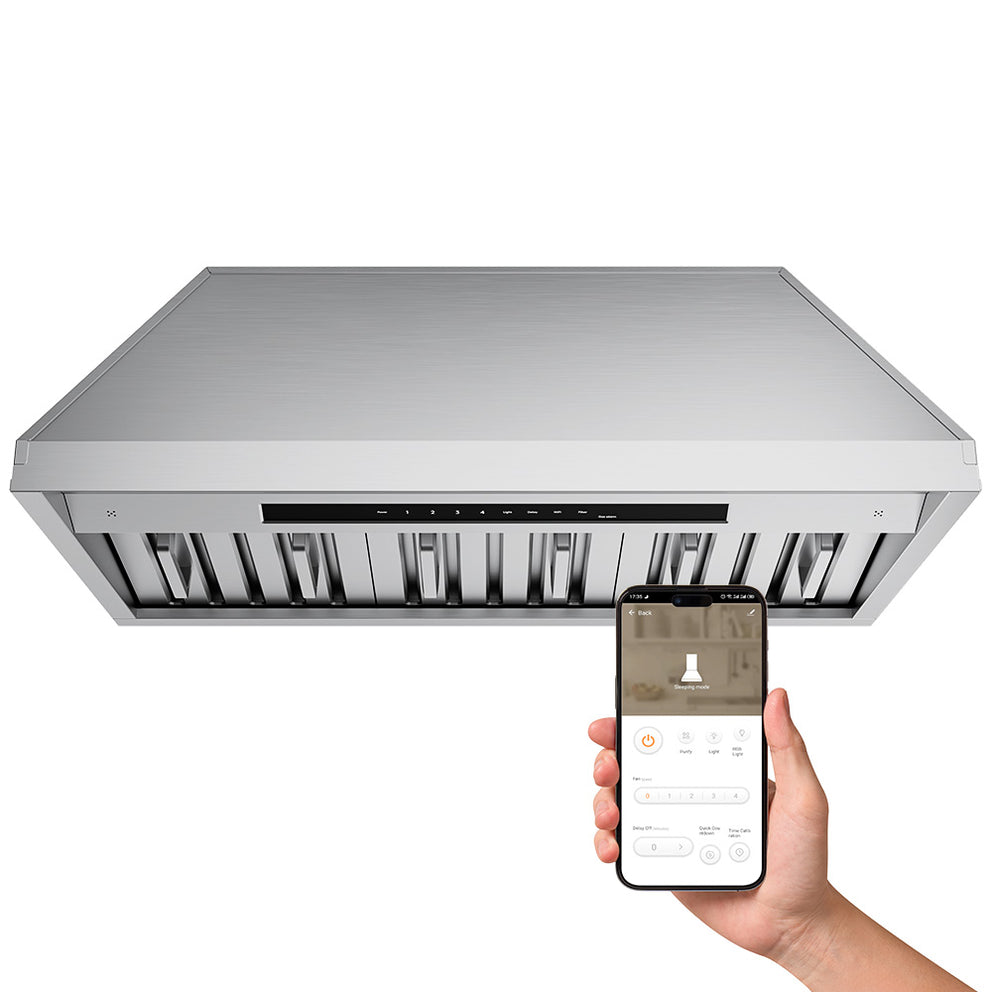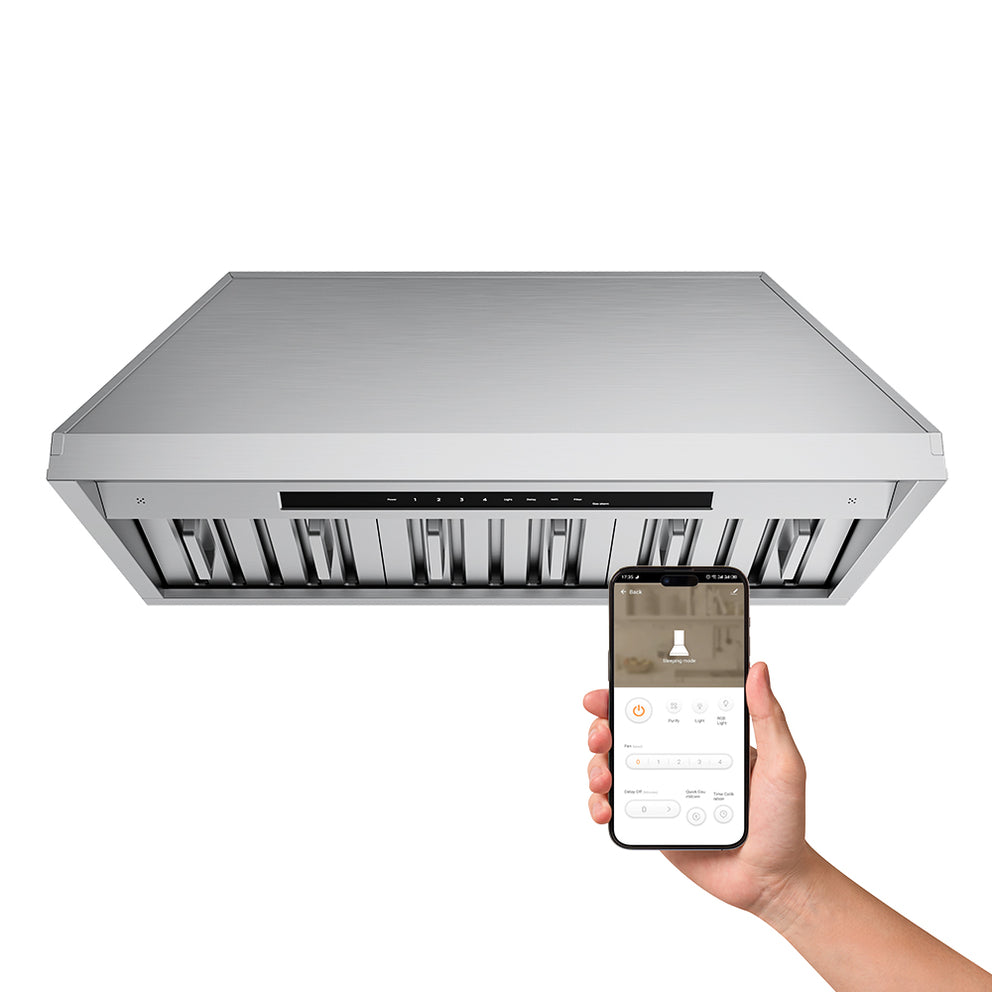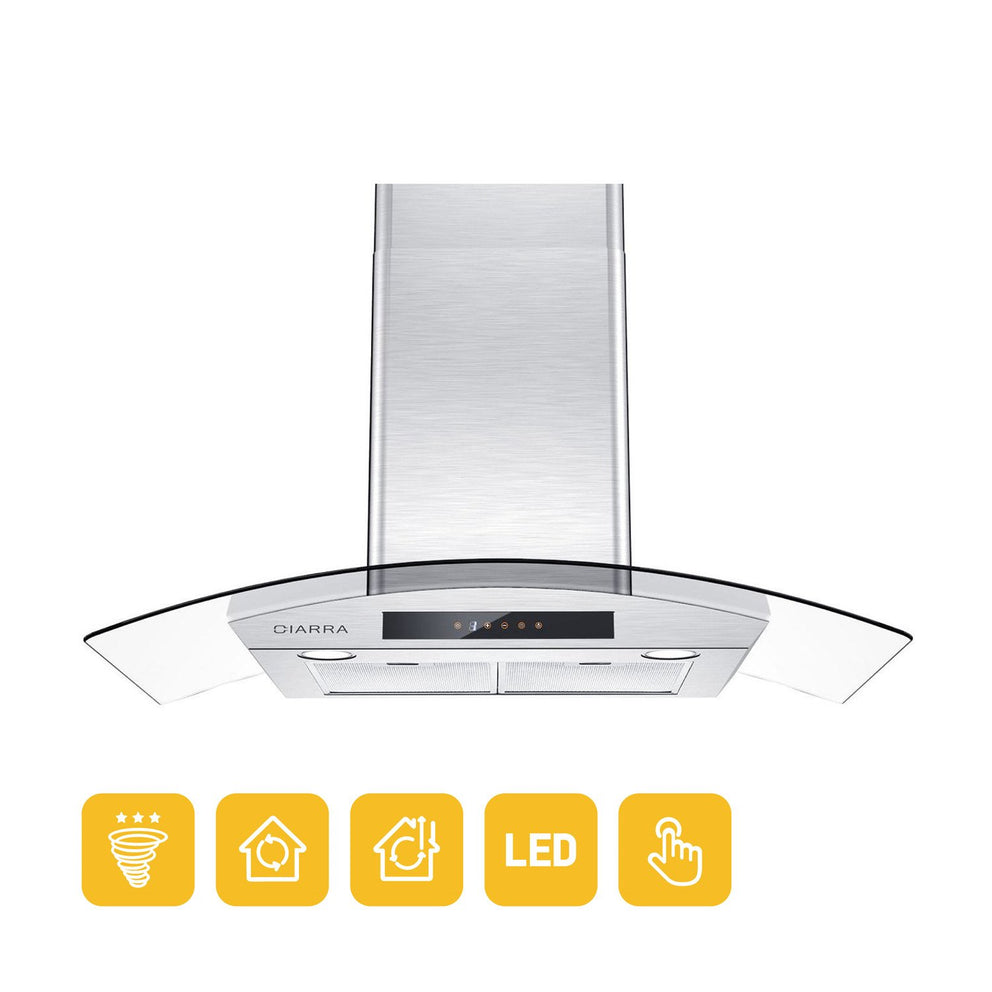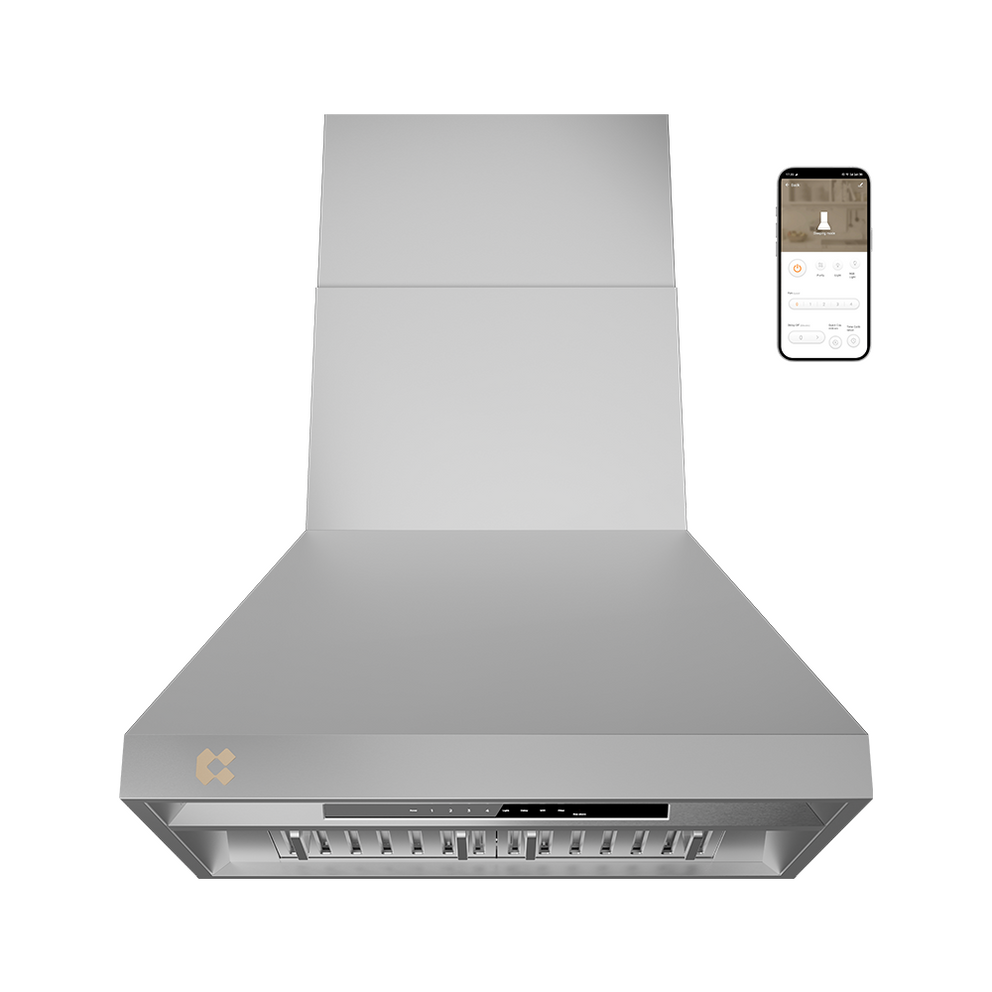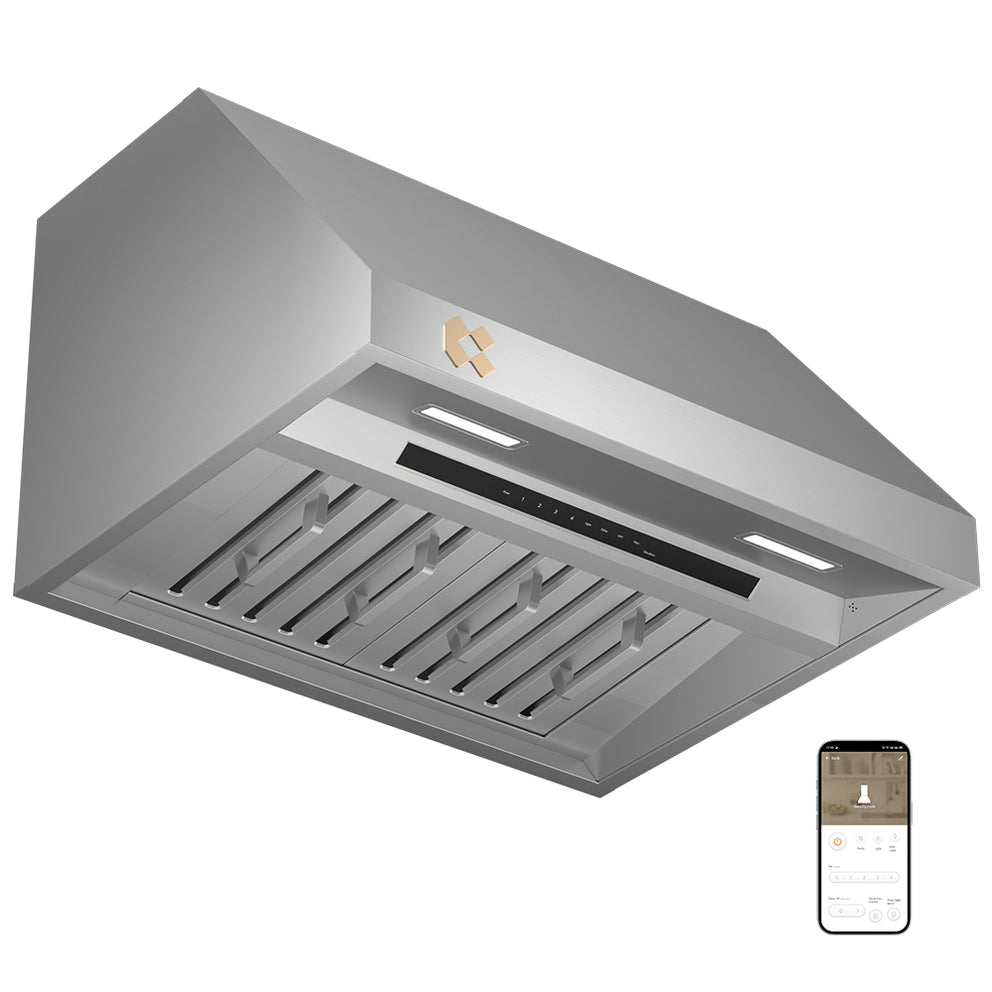When designing a kitchen that prioritizes cleanliness, performance, and efficiency, the choice of range hood is more than just a design decision—it's a functional one. Among the various types available, ducted range hoods stand out as the most effective solution for serious cooking enthusiasts and professionals alike.
In this article, we’ll explore what ducted range hoods are, how they work, their advantages over ductless models, and why they may be the right choice for your home.
What Exactly is a Range Hood?
A range hood, also known as an extractor hood or vent hood, is a kitchen appliance installed above your cooking surface to capture airborne pollutants generated during cooking. These can include:
- Smoke and steam
- Grease particles
- Odors
- Excess heat and moisture
The hood uses a fan (also called a blower) to draw these pollutants away from your cooktop. Where the air goes next depends on whether your hood is ducted or ductless.

Ducted vs. Ductless Range Hoods: The Fundamental Difference

| Ductless Range Hoods filter and recirculate air back into the kitchen. While easier to install with no ductwork required, they offer limited effectiveness and only partially remove contaminants. | Ducted Range Hoods vent air outside through ductwork, completely removing smoke, odors, and grease from your kitchen. They offer superior ventilation but require installation of external ducting. |
Common Sizes & Types of Ducted Range Hoods
Common Sizes
Ducted range hoods come in several standard sizes designed to match the width of your cooktop or range. Choosing the right size ensures optimal capture of smoke and grease.
30-Inch Range Hoods
One of the most popular sizes, ideal for standard 4-burner cooktops. Often comes with powerful suction options like 900 CFM, making it suitable for heavy-duty cooking.
36-Inch Range Hoods
Perfect for larger cooktops or ranges with five or more burners. Offers broader coverage and higher extraction rates, ideal for open kitchens or frequent cooks.
Other Sizes Available:
24-inch – For compact kitchens or small cooking areas
48-inch and 60-inch – For commercial-style ranges or oversized kitchens
Types of Ducted Range Hoods
1. Wall-Mounted Ducted Range Hoods
Installed directly on the wall above your stove, these chimney-style hoods are both functional and stylish. They often serve as a kitchen focal point and connect to ductwork through the wall or ceiling.
2. Under-Cabinet Ducted Range Hoods
Mounted beneath kitchen cabinets, these models are compact and ideal for smaller kitchens. A 30-inch 900 CFM ducted under-cabinet range hood provides excellent power while maintaining a low profile.
3. Island-Mounted Ducted Range Hoods
Designed for cooktops located on kitchen islands. These hoods are suspended from the ceiling and vent air upward through ceiling-mounted ductwork. They often feature sleek, modern designs to match open-concept spaces.
4. Built-In / Insert Ducted Range Hoods
Concealed inside custom cabinetry or hood surrounds, insert hoods are ideal for a seamless kitchen design. They provide powerful ducted ventilation while remaining discreet.
5. Downdraft Ducted Range Hoods
Installed behind or beside the cooktop and vent air downwards through ducts built into the cabinetry. Best suited for kitchens with design constraints where overhead hoods are not practical.
Why Ducted Range Hoods Are The Superior Choice
When it comes to kitchen ventilation, ducted range hoods consistently outperform ductless models in almost every category. From air quality to grease management, here’s why ducted hoods are the clear winner for serious cooks and healthier homes:
1. Superior Ventilation Performance
Ducted range hoods remove cooking byproducts—smoke, grease, odors, heat, and airborne contaminants—directly out of your home. This physical expulsion of polluted air offers a level of performance that no filtration system can match. While ductless hoods rely on recirculating air through filters, ducted systems eliminate the problem at the source.
Fact: A high-quality ducted hood can extract up to 2000 CFM, whereas even the best ductless models struggle to clean just a fraction of that effectively.
2. True Odor Elimination
Ducted range hoods don’t just reduce smells—they remove them entirely. Whether you’re cooking garlic shrimp, searing steak, or deep-frying fish, the odors are sent outside before they can spread through your home.
No lingering food smells in fabrics or upholstery
No need for air fresheners or constant filter replacement
Your home stays fresh and breathable after every meal
3. Better Moisture and Heat Control
Cooking—especially boiling, steaming, and frying—produces large amounts of heat and steam. If not vented properly, this moisture can:
Warp wood cabinets
Peel paint or wallpaper
Encourage mold or mildew growth
Create a hot, uncomfortable kitchen
A ducted hood vents this hot, humid air outside, maintaining a more comfortable and damage-free kitchen environment.
4. Superior Grease Removal
Cooking vapor carries fine grease particles that settle on cabinets, walls, and ceilings—forming a sticky residue that attracts dust and is hard to clean. Ducted hoods extract these particles from the air before they can settle, keeping your kitchen:
Cleaner for longer
Easier to maintain
Free from buildup that can become a fire hazard over time
5. Improved Indoor Air Quality
For anyone with asthma, allergies, or respiratory concerns, indoor air quality is crucial. Ducted hoods remove:
Fine particulates
Volatile organic compounds (VOCs)
Excess carbon dioxide
Smoke and airborne allergens
This makes them an ideal solution for households with children, pets, or sensitive individuals who need fresher, cleaner air.
6. Quieter Operation at High Power
Because they don’t rely on dense carbon filters or internal recirculation systems, ducted range hoods often run more quietly, even at high speeds. With the blower typically located further away (sometimes even outside), the reduction in noise can make a big difference—especially in open-plan kitchens.
7. Lower Long-Term Maintenance Costs
Ductless hoods require frequent filter replacements (every 3–6 months), which can add up over time. Ducted models, in contrast:
Do not require odor filters
Only need periodic cleaning of metal grease filters
Offer greater cost efficiency in the long run
8. Better for Open-Concept and Large Kitchens
If your kitchen opens into a dining or living area, it’s critical to control smoke and odor effectively. Ducted hoods provide the power and reach needed to maintain air quality in larger, open spaces, where recirculation simply doesn’t cut it.
How to Install Range Hood Duct
Choose Venting Path: Decide whether to vent through a wall or ceiling.
Measure & Mark: Center the hood above the cooktop and mark mounting points.
Cut Duct Opening: Use a jigsaw or hole saw to cut a hole for the duct.
Install Exterior Vent Cap: Mount and seal the vent cap outside with silicone.
Mount the Range Hood: Attach the hood securely to the wall or cabinet.
Connect Ductwork: Use metal ducting and aluminum tape to seal all joints.
Power Up: Plug in or hardwire the hood, then test for proper airflow.
Tip: Keep the duct as short and straight as possible for best performance.
A Few Key Notes on Ducted Hoods
When installing and using a ducted range hood, here are a few important tips to ensure safety, efficiency, and long-term performance:
Install a Roof or Wall Vent Cap
Proper outdoor venting is essential. Always use a high-quality roof or wall cap to prevent backdrafts, moisture intrusion, or pest entry.
Consider an Inline Blower for Quieter Operation
For powerful yet quiet performance, an inline blower (installed within the duct run) is a great option. It reduces noise at the hood while maintaining strong suction.
Keep Ducting Short and Straight
The fewer bends and turns, the better. A straight, short duct path improves airflow efficiency and minimizes pressure loss.
Seal Duct Joints Properly
Use aluminum foil tape (not duct tape) to seal all connections and prevent air leaks.
Follow Local Codes
Always check building codes for duct size, venting requirements, and electrical safety standards in your area.
Recommended Ciarra Ducted Range Hood
30-inch 950 CFM Ducted Under-cabinet Range Hood
Elevate your kitchen ventilation with the CIARRA Professional Series 30-inch Under-Cabinet Range Hood, designed to combine powerful performance with smart convenience and modern style.
Key Features:
- Powerful Ventilation: Up to 950 CFM extraction to quickly remove smoke, grease, and odors.
- Gas Leakage Detection: Built-in sensors alert you to potential gas leaks for enhanced kitchen safety.
- Filter Cleaning Reminder: Smart alerts help you keep the dishwasher-safe baffle filters clean for optimal performance.
- Smart Controls: 4-speed touch panel with boost function, plus WiFi and voice control via Alexa and Google Home.
- Durable Design: Stainless steel construction resists rust, heat, and corrosion for long-lasting use.
- Dual Ventilation Ready: Supports external venting or internal purification with optional Plasma⁺ System.
You may be interested in:
2025 Best Range Hood with Gas Leakage Detectors for Gas Stove
CIARRA Wall Mount Range Hood 30 Inch with Delay Shut off 3-speed Extraction CAS75206-OW
- Strong Suction: 450 CFM efficiently removes kitchen smoke and odors with noise below 8.5 Sones.
- Smart Functions: Touch control panel with 3-speed settings and 5–20 min delay shut-off for post-cooking ventilation.
- Clean & Fresh Mode: Automatically ventilates for 5 mins every hour (24-hour cycle) to keep air fresh and reduce residual fumes.
- Flexible Venting: Convertible between ducted and ductless operation.
- Durable Build: Aluminum motor housing ensures long-lasting stability and performance.
- Energy-Saving LED Lighting: Two integrated 1.5W LED lights provide clear cooking visibility.
Best for users who prefer modern touch control and continuous air freshness in compact kitchens.
CIARRA 30 Inch Wall Mount Range Hood with Delay Shut off 3-speed Extraction CAS75308-OW
- 450 CFM High Extraction Rate: Effectively captures cooking fumes and odors with low noise operation.
- Mechanical Push Button Controls: Reliable, intuitive interface with 3 fan speeds.
- Clean & Fresh + Delay Shut-Off: Keeps air clean after cooking and improves long-term ventilation.
- 5-Layer Aluminum Filters: Efficient grease and moisture capture, easy to remove and clean.
- Dual Ventilation Modes: Supports both external ducting and recirculating (carbon filter required).
- LED Lighting: Bright, cost-efficient illumination of the cooking area.
Ideal for those who prefer traditional controls and value performance at an affordable price.
CIARRA 36 Inch Glass Wall Mount Range Hood with 3-speed Extraction CAS90502-OW
- Elegant Curved Glass Design: Timeless style with powerful 450 CFM suction to centralize and eliminate smoke.
- Wider Coverage: 36-inch size ideal for larger stovetops.
- Touch Control + Clean & Fresh Mode: Maintains fresh kitchen air around the clock.
- 5-Layer Aluminum Filters + Delay Shut-Off: Enhanced grease capture and hands-free operation after cooking.
- Premium Motor Housing: Cast aluminum construction ensures durability and quiet performance.
- 24-Month Warranty: Peace of mind for long-term use.
- LED Lighting: Energy-efficient lights enhance cooking visibility.
Perfect for modern kitchens that demand style, performance, and larger hood coverage.
Explore this detailed video showcasing CIARRA’s ducted range hoods—you’ll discover why these models are so favored in U.S. kitchens:
When Might a Ductless Hood Be Acceptable?
A ductless range hood can be a practical solution when installing ductwork is not feasible, such as in apartments, condos, or rental properties where structural modifications are prohibited. In the UK and across Europe, local regulations and property agreements often restrict alterations to external walls—like installing ducted vents—especially in rental or heritage buildings. These restrictions exist to protect the building’s structural integrity, maintain its appearance, and ensure safety.
Additionally, landlords are legally required to provide adequate mechanical ventilation in kitchens to prevent dampness and ensure the property remains habitable, as mandated by laws such as the Homes (Fitness for Human Habitation) Act 2018. When ventilation improvements coincide with energy efficiency upgrades, careful planning is essential to avoid compromising indoor air quality.
Ductless range hoods may also be appropriate for kitchens with light cooking needs or temporary setups where budget or space constraints make ducted installation impractical. Although they do not match the performance of ducted models, ductless hoods can still offer basic filtration of smoke, odors, and grease—provided that filters are regularly cleaned or replaced.
However, for frequent, heavy-duty cooking or long-term use, ductless hoods are a compromise and should not be considered a full substitute for ducted ventilation systems.
Conclusion
While ductless range hoods offer a convenient solution for certain spaces, ducted range hoods are the clear winner when it comes to performance, efficiency, and long-term air quality.
If your kitchen layout allows for exterior venting, investing in a ducted range hood will significantly improve your cooking experience—keeping your home cleaner, healthier, and more comfortable.
Explore CIARRA® Professional Range Hoods
Clearing the air so you can sear, simmer, and flambé is a must for any adventurous cook. That’s why CIARRA® professional range hoods are built to fit any kitchen space, offering five different types of high-performance hoods. Breathe new life into your kitchen with a professional range hood designed to meet your cooking needs and elevate your culinary experience.






